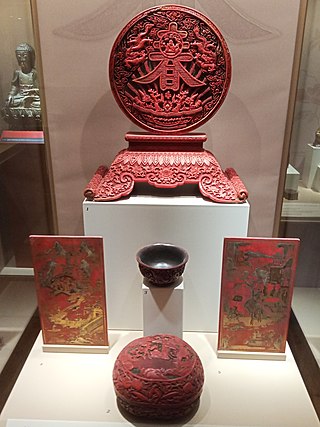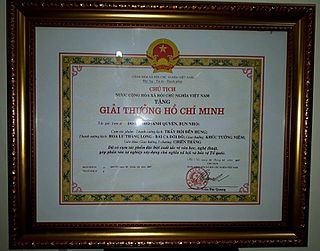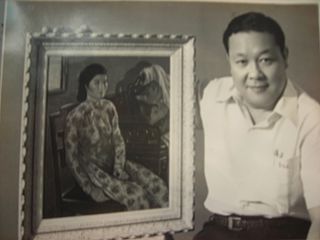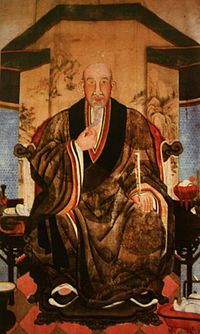
Lacquerware are objects decoratively covered with lacquer. Lacquerware includes small or large containers, tableware, a variety of small objects carried by people, and larger objects such as furniture and even coffins painted with lacquer. Before lacquering, the surface is sometimes painted with pictures, inlaid with shell and other materials, or carved. The lacquer can be dusted with gold or silver and given further decorative treatments.

Áo dài is a modernized Vietnamese national garment consisting of a long split tunic worn over silk trousers. It can serve as formalwear for both men and women. Áo translates as shirt and dài means "long". The term can also be used to describe any clothing attire that consists of a long tunic, such as nhật bình.

Vietnamese clothing or Việt phục (越服) is the traditional style of clothing worn in Vietnam by the Vietnamese people. The traditional style has both indigenous and foreign elements due to the diverse cultural exchanges during the history of Vietnam. Due to it being part of the Sinosphere, Vietnamese traditional clothing have elements which bear similarities to those of China, Korea, and Japan. This all eventually led to the birth of a distinctive Vietnamese style of clothing, including the birth of the modern national dress of Vietnam, the áo dài.

Vietnamese art is visual art that, whether ancient or modern, originated in or is practiced in Vietnam or by Vietnamese artists.

The White Silk Dress is a 2006 Vietnamese war film directed by Luu Huynh starring Truong Ngoc Anh and Nguyen Quoc Khanh. With a budget of over 2 million dollars, it is one of the most expensive Vietnamese films ever made.
The Vietnam University of Fine Arts is an art school in Hanoi, Vietnam originally established under French colonial rule in 1925. The university has trained many of Vietnam’s leading artists and each year it participates in many cultural exchanges with sister institutions overseas.

The Hồ Chí Minh Prize is an honorary award given by the government of Vietnam in recognition of cultural and/or scientific achievement. The prize was established by decree in 1981, and has been awarded in 1996, 2000, 2005 and 2012, often posthumously. The prize is named for Ho Chi Minh, who was Chairman and founder of the Workers' Party of Vietnam, that is considered one of the highest honors bestowed by Vietnam.
Trần Văn Cẩn was a Vietnamese painter.

Nguyen Gia Tri or Nguyễn Gia Trí was a Vietnamese painter best known for his lacquer paintings. He also drew cartoons on political and social issues, many of them criticising French colonial rule.

Nguyen Phan Chanh was born in a rural Vietnamese village, in Ha Tinh province. His early education was in Chinese, and he studied Chinese calligraphy so as to pass the qualifying exams for the title of Mandarin. However, the exams were abolished before he was old enough to sit them. With his first ambition thwarted, it was decided that he should continue studying painting at the l’Ecole des Beaux-arts d’Indochine in Hanoi.

Nguyễn Văn Duyến, art name Tú Duyên was a Vietnamese painter.

Đào Sĩ Chu (1909-1974) was a Vietnamese painter who studied in France and was known for following the traditional style of the EBAI school. He was also an organizer of art exhibitions and writer on the history of art.
Joseph Inguimberty was a French painter, and teacher at the École des Beaux-Arts de l'Indochine (EBAI) in Hanoi 1926–1945. His teaching was appreciated for being less academic than the director Victor Tardieu. He shared with Tardieu a keen interest in Vietnam's culture. Inguimberty encouraged his students to experiment with lacquer painting as a fine art painting medium.
Alix Angèle Marguerite Aymé was a female French painter who lived in China and Vietnam.

Vạn Phúc is a village traditionally associated with silk weaving in Hà Đông, 8 km south-west of Hanoi. In Vietnamese it is called both làng lụa Vạn Phúc "Van Phuc silk village" and làng lụa Hà Đông after the larger village ("làng") area name.
The Mai Dịch Cemetery is a cemetery in Hanoi, Vietnam, which houses the graves of Communist government leaders and famous revolutionaries.
Trần Quang Trân, also Tran Quang Tran, (1900–1969) was a lacquer artist and a Vietnamese painter.
Witness Collection is one of the largest private collection of Vietnamese art in the world. It undertakes detailed research into the art in its collection and Vietnam's 20th century history, as well as providing state-of-the-art conservation.

The abdication of Bảo Đại took place on 25 August 1945 and marked the end of the 143-year reign of the Nguyễn dynasty over Vietnam ending the Vietnamese monarchy. Emperor Bảo Đại abdicated in response to the August Revolution. A ceremony was held handing power over to the newly established Democratic Republic of Vietnam, which was established during the end of World War II in Asia as Vietnam had been occupied by French and later Japanese imperialists.













